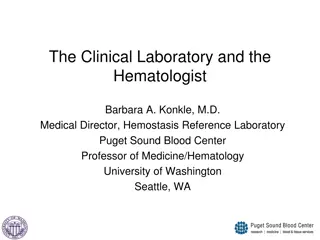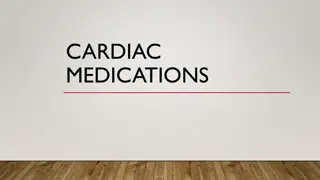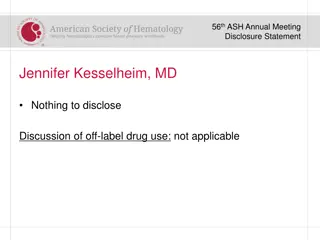Understanding Anticoagulants in Laboratory Hematology
Anticoagulants are crucial additives that prevent blood clotting during laboratory procedures. The commonly used anticoagulants include EDTA, sodium citrate, and heparin, each with specific concentrations, modes of action, and color-coded identifications. EDTA is ideal for blood cell counts, sodium citrate is used in coagulation tests, and heparin naturally prevents clot formation. Understanding the differences and applications of these anticoagulants is essential for accurate and reliable laboratory results.
Download Presentation

Please find below an Image/Link to download the presentation.
The content on the website is provided AS IS for your information and personal use only. It may not be sold, licensed, or shared on other websites without obtaining consent from the author. Download presentation by click this link. If you encounter any issues during the download, it is possible that the publisher has removed the file from their server.
E N D
Presentation Transcript
Anticoagulant Anticoagulant Anticoagulants Anticoagulants: : are additives that inhibit clotting of blood and/or plasma. They act either by binding calcium ions or by inhibiting thrombin activity. Platelets and coagulation factors are activated when blood vessels are punctured, and their activation continues in sample containers that do not contain anticoagulant, leads to clot formation which interfere with many analytical tests. Most hematology and coagulation procedures must be performed on whole blood or plasma. There for, as soon as the blood is withdrawn from the patient, it is mixed with an anticoagulant to prevent coagulation. The three most commonly used anticoagulants in the hematology laboratory are:
1 1- -EDTA( EDTA(ethylene Uses Uses: EDTA is usually used for blood cell counts Concentration Concentration: It is used in concentration of 1.2 ( 0.2) mg of salt per one ml of blood. Mode of action Mode of action: EDTA prevents coagulation by binding the calcium in the blood (calcium is required for blood coagulation). Available form: Available form: It is generally available as the sodium, dipotassium or tripotassium salt of ethylene diamine tetra acetic acid. Dipotassium EDTA coat the inside surface of the blood collection tube with a thin layer. ethylene diamine diamine tetra acetic acid tetra acetic acid) ) Tripotassium EDTA is added in liquid form. Color code Color code: Blood collection tube containing EDTA is coded by a pink or lavender colored cap.
Excessive concentration of EDTA cause: Excessive concentration of EDTA cause: 1. Shrinkage of the red blood cells 2. Changes in the white cells and the platelets will swell and break up causing a falsely increased platelet counts. 2 2- -Sodium citrate: Sodium citrate: Uses: Uses: used for coagulation tests and ESR Concentration Concentration: Is used for coagulation studies in a concentration of 1 part 3.2% sodium citrate to9 part whole blood. For the erythrocyte sedimentation rate (ESR), four volumes of blood are added to 1 volume of the sodium citrate solution. Mode of action Mode of action: Sodium citrate prevents coagulation by binding the calcium of the blood in a soluble complex. Form Form: tri sodium citrate. Color code Color code: blue Disadvantages of Sodium Citrate; Disadvantages of Sodium Citrate; 1. It interferes with many chemical tests 2. It has a tendency to shrink cells. 3. Causes blood dilution, therefore, sodium citrate is generally not used for complete blood count (CBC)
3-Heparine: - It present naturally in the blood to prevent clots inside the body. Concentration: May be used in concentration of 15 to 30 units/ml of whole blood. - Mode of action: Coagulation is prevented by interaction with anti thrombin III and inhibition of thrombin. Color code: green, red tip for capillary tubes (plain capillary with blue tip).
Uses Uses: It does not alter the size of the red cells and it is recommended when it is important to reduce the chance of lysis. Disadvantage Disadvantage: It should not be used for making blood films as it gives a faint blue coloration to the background when the films are stained. Oxalate Oxalate Forms Forms: This may be sodium, potassium, ammonium or lithium oxalic acid salt used as an anticoagulant. Mode of action Mode of action: form insoluble complex with calcium ions. Concentration: Concentration: Potassium oxalate at a concentration of 1 to 2 mg/mL of blood is used. This is the most popular oxalate salt used as an anticoagulant. The combination of ammonium/potassium oxalate does not lead to shrinkage of the RBCs. While other oxalates cause shrinkage. Disadvantages: Disadvantages: If the concentration is >3 mg/mL, then there are chances for hemolysis. There is a reduction of 10 % of hematocrit. Oxalates inhibit several enzymes like acid phosphatase, alkaline phosphatase, amylase, LDH, and may cause the precipitation of calcium as oxalate salt.
Sodium Fluoride Sodium Fluoride Forms Forms This is a weak anticoagulant but used an antiglycolytic agent to preserve the glucose. Color code Color code: grey Mode of action: Mode of action: This inhibits the system involved in glycolysis and preserve the glucose. Concentration Concentration: effective at a concentration of 2 mg/mL of blood along with another anticoagulant like oxalate.When used alone then more concentration than 2 mg/mL is needed. Notes: This is mostly used for glucose estimation. Most specimens are preserved at 25 C for 24 hours and at 4 C for 48 hours. Sodium fluoride is poorly soluble so mix blood thoroughly before anti glycolysis occurs. Disadvantages Disadvantages: also an inhibitor of many enzymes. effect urease for the estimation of urea.

























